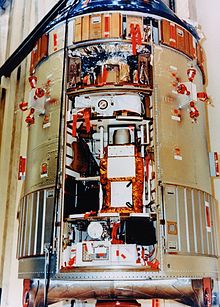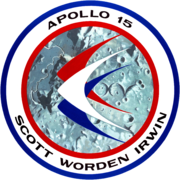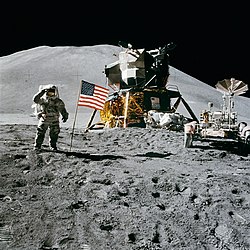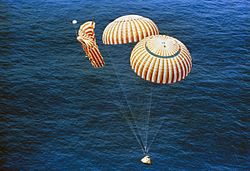Apollo 15
| COSPAR ID | 1971-063A |
|---|---|
| SATCAT no. | 05351 |
| Crew | |
| Members | 3 people |
File:Apollo-15-LOGO.png
 | |
Apollo 15 was the ninth manned mission in the Apollo program and the fourth mission to land on the Moon. It was the first of what were termed J missions — long duration stays on the Moon with a greater focus on science than had been possible on previous missions.
Commander David Scott and Lunar Module Pilot James Irwin spent three days on the Moon and a total of 18½ hours outside the spacecraft on lunar extra-vehicular activity. The mission was the first not to land in a Lunar mare, instead landing near Hadley rille in an area of the Mare Imbrium called Palus Putredinus (Marsh of Decay). The crew explored the area using the first Lunar Rover allowing them to travel much further from the Lunar Module lander than had previously been possible. They collected a total of 77 kg (170 lb) lunar surface material.
At the same time Command Module Pilot Alfred Worden orbited the Moon, using a Scientific Instrument Module (SIM) to study the lunar surface and environment in great detail using a panoramic camera, gamma ray spectrometer, mapping camera, laser altimeter, mass spectrometer, and lunar sub-satellite that was launched at the end of the mission.
Crew
- David Scott (3), commander
- Alfred Worden (1), command module pilot
- James Irwin (1), lunar module pilot
*Number in parentheses indicates number of spaceflights by each individual prior to and including this mission.
All three astronauts received degrees from the University of Michigan.
Backup crew
The backup crew trained to take the place of the prime crew in case of illness or death.
- Dick Gordon, commander
- Vance Brand, command module pilot
- Harrison Schmitt, lunar module pilot
Support crew
The support crew were not trained to fly the mission but were able to stand in for astronauts in meetings and be involved in the minutiae of mission planning, while the prime and backup crews trained. They often also served as Capsule Communicators (CapComs) during the mission. All three support crew members would later fly into space onboard the Space Shuttle.
- Joe Allen (flew on STS-5 and STS-51-A)
- Bob Parker (flew on STS-9 and STS-35)
- Karl Henize (flew on STS-51-F)
Flight directors
- Gerald Griffin, Gold team
- Milton Windler, Maroon team
- Glynn Lunney, Black team
- Gene Kranz, White team
Mission parameters
- Mass:
- Launch mass: 2,921,005 kg
- Total spacecraft: 46,782 kg
- CSM mass: 30,354 kg, of which CM was 5840 kg, SM 24,514 kg
- LM mass: 16,428 kg, ascent stage at lunar liftoff 4,951 kg
- Earth orbits: 3 before leaving for Moon, about one on return
- Lunar orbits: 74
Earth parking orbit
- Perigee: 169.5 km
- Apogee: 171.3 km
- Inclination: 29.679°
- Period: 87.84 min
LM-CSM docking
- Undocked: 1971-07-30 - 18:13:16 UTC
- Docked: 1971-08-02 - 19:10:25 UTC
EVAs
- Scott - Stand up EVA - LM upper hatch
- Start Stand Up EVA: 1971-07-31, 00:16:49 UTC
- End Stand Up EVA: July 31, 00:49:56 UTC
- Duration: 33 minutes, 07 seconds
- Scott and Irwin - EVA 1
- EVA 1 Start: 1971-07-31, 13:12:17 UTC
- EVA 1 End: July 31, 19:45:59 UTC
- Duration: 6 hours, 32 minutes, 42 seconds
- Scott and Irwin - EVA 2
- EVA 2 Start: 1971-08-01, 11:48:48 UTC
- EVA 2 End: August 1, 19:01:02 UTC
- Duration: 7 hours, 12 minutes, 14 seconds
- Scott and Irwin - EVA 3
- EVA 3 Start: 1971-08-02, 08:52:14 UTC
- EVA 3 End: August 2, 13:42:04 UTC
- Duration: 4 hours, 49 minutes, 50 seconds
- Worden - Transearth EVA 4
- EVA 4 Start: 1971-08-05, 15:31:12 UTC
- EVA 4 End: August 5, 16:10:19 UTC
- Duration: 39 minutes, 07 seconds
Mission highlights
Incident
Shortly after stage 1 separation, the instrumentation on stage 1 went dead. This was traced to the exhaust of stage 2 striking the stage and burning out the electronics. This had never happened before; and was traced to a reduction in the number of retrofire charges from 8 to 4. It was discovered that the two stages were in fact uncomfortably close, due to the slow thrust decay of the F-1 engines, and failure of any one charge could have caused a collision. Later flights had the original retrofire configuration.
Planning and training

The crew for Apollo 15 had previously served as the backup crew for Apollo 12. There had been a friendly rivalry between that prime and backup crew on that mission, with the prime being all Navy, and the backup all Air Force.
Originally Apollo 15 would have been an H mission, like Apollos 12, 13, 14. But on September 2, 1970, NASA announced it was cancelling what were to be the current incarnations of the Apollo 15 and Apollo 19 missions. To maximize the return from the remaining missions, Apollo 15 would now fly as a J mission and have the honor of carrying the first Lunar Rover.
One of the major changes in the training for 15 was the geology training. Although on previous flights the crews had been trained in field geology, for the first time 15 would make it a high priority. Scott and Irwin would train with Lee Silver, a Caltech geologist who on Earth was interested in the Precambrian. Silver had been suggested by Harrison Schmitt as an alternative to the classroom lecturers that NASA had previously used. Among other things, Silver had made important refinements to the methods for dating rocks using the decay of uranium into lead in the late 1950s.
At first Silver would take the prime and backup crews to various geological sites as if for a normal field geology lesson, but as launch time approached, these trips became more realistic. Crews began to wear mock-ups of the backpacks they would carry, and communicate using walkie-talkies to a CapCom in a tent. (During a mission the Capsule Communicators, CapComs, were the only people who normally would speak to the crew). The CapCom was accompanied by a group of geologists unfamiliar with the area who would rely on the astronauts' descriptions to interpret the findings.
The decision to land at Hadley came in September 1970. The Site Selection Committees had narrowed the field down to two sites—Hadley Rille or the crater Marius, near which were a group of low, possibly volcanic, domes. Although not ultimately his decision, the commander of a mission always held great sway. To Dave Scott the choice was clear, with Hadley, being "exploration at its finest".
Command Module Pilot Al Worden undertook a different kind of geology training. Working with an Egyptian, Farouk El-Baz, he flew over areas in an airplane simulating the speed at which terrain would pass below him while in the CSM in orbit. He became quite adept at making observations as the object traveled below.
Hardware
The Lunar Roving Vehicle, or the Rover, had been in development since May 1969, with the contract awarded to Boeing. It could be folded into a space 5 ft by 20 in (1.5 m by 0.5 m). Unloaded it weighed 460 lb (209 kg) and when carrying two astronauts and their equipment, 1500 lb (700 kg). Each wheel was independently driven by ¼ horsepower (200 W) electric motor. Although it could be driven by either astronaut, the Commander always drove. Travelling at speeds up to 6 to 8 mph (10 to 12 km/h), it meant that for the first time the astronauts could travel far afield from their lander and still have enough time to do some serious science.
The Saturn V that launched Apollo 15 was designated SA-510, the tenth flight-ready model of the rocket. Apollo 15 used Command/Service Module CSM-112, which was given the callsign Endeavour, named after the HM Bark Endeavour and Lunar Module LM-10, callsign Falcon, named after the United States Air Force Academy mascot. If Apollo 15 had flown as an H mission it would with CSM-111 and LM-9. The CSM was used by the Apollo Soyuz Test Project and the Lunar Module was unused and is now on display at the Kennedy Space Center.
As the payload of the rocket was greater, changes were made to its launch trajectory and Saturn V itself. The rocket was launched in a more southerly direction (80–100 degrees azimuth) and the Earth parking orbit lowered to 166 km (90 nautical miles) above the Earth's surface. These two changes meant 1100 pounds (500 kg) more could be launched. The propellant reserves were reduced and the number of retrorockets on the S-IC first stage reduced from eight to four. The four outboard engines of the S-IC would be burned longer and the center engine would also burn longer before being shutdown (see Saturn V for more information on the launch sequence). Changes were made to the S-II second stage to stop pogo oscillations.
On the Lunar Module, the fuel and oxidizer tanks were enlarged on both the descent and ascent stages and the engine bell on the descent stage was extended. Batteries and solar cells were added for increased electrical power. In all this increased the weight of the Lunar Module to 36,000 pounds (16,330 kilograms), 4000 pounds (1800 kg) heavier than previous models.
The astronauts themselves wore new spacesuits. On all previous Apollo flights, including the non-lunar flights, the commander and lunar module pilot had worn suits with the life support, liquid cooling, and communications connections in two parallel rows of threes. On Apollo 15, the new suits, dubbed the "A7L-B," have the connectors situated in triangular pairs. This new arrangement, along with the relocation of the entry zipper (which went in an up-down motion on the old suits), from the right shoulder to the left hip, allowed the inclusion of a new waist joint, allowing the astronauts to bend completely over, and even to sit on the rover. Upgraded backpacks allowed for longer-duration moonwalks, and the command module pilot, who wore a suit with three connectors, would wear a five-connector version of the old moon suit--the liquid cooling water connector being removed, as the command module pilot would make a "deep-space EVA" to retrieve film cartridges on the flight home.

Technicians at the Kennedy Space Center had many problems with the SIM bay. It was the first time it had flown and experienced problems from the start. Problems came from the fact the instruments were designed to operate in zero gravity, but had to be tested in the 1 g on the surface of the Earth. As such things like the 7.5 m booms for the mass and gamma ray spectrometers could only be tested using railings that tried to mimic the space environment, though never worked particularly well. When the technicians tried to integrate the entire bay into the rest of the spacecraft, data streams would not synchronize and lead investigators of the instruments would want to make last minute checks and changes. When it came time to test the operation of the gamma-ray spectrometer it was necessary to stop every engine within 10 miles (16 km) of the test site.
Once all the various components had been installed on the Saturn V, it was moved to the launch site, Launch Complex 39A. During late June and early July 1971, the rocket and Mobile Service Structure were struck by lightning at least four times. All was well however, with only minor damage suffered.
- The following is a brief overview of the Apollo 15 mission. For more in-depth information, see each the main article for each section.
Outward journey
 |
| Part of a series on |
| Apollo 15 |
|---|
|
Launching at 9:34:00 am EDT on 1971-07-26, Apollo 15 would take four days to reach the Moon. After spending two hours in orbit around the Earth, the S-IVB third stage of the Saturn V was reignited to send them to the Moon.
During the retrieval of the LM from its stowed position below the CSM, a light came on the control panel that indicated the valves of the Service Propulsion System were open and the engine should be firing. A short was found in a switch that controlled on the redundant valves for the engine. New procedures were developed to deal with this. During their first inspection of the LM, Scott and Irwin found that the glass cover of a tapemeter had broken forcing them to clean up the glass shards lest they breathe them in.
On the fourth day they entered into lunar orbit and prepared for lunar descent.
Solo operations
During the three day explorations of the Moon by Scott and Irwin, Worden had a busy schedule of observations. Apollo 15 was the first mission to carry the SIM bay, which contained a panoramic camera, gamma ray spectrometer, mapping camera, laser altimeter and mass spectrometer. Worden had to operate the shutter and lenses on the camera and turn on and off the various instruments. During the coast back to Earth, he would perform an EVA to retrieve film cassettes from the cameras.
Lunar surface


Apollo 15 was the first mission to perform three EVAs on the lunar surface. After landing at 26°8′ N 3°38′ E, Scott removed the top hatch of the LM to perform a site survey and get a brief overview of the surrounding areas. The first EVA took the crew on the Rover to the base of Mount Hadley Delta. Back at the LM the crew started the deployment of the Apollo Lunar Surface Experiment Package (ALSEP). Scott had extreme difficulty drilling the holes for the heat-flow experiment, forcing him to come back the next day to complete the task.
The second EVA again took Scott and Irwin to the base of Mount Hadley Delta but they went up its slope. Here they found the Genesis Rock. Returning to the LM, Scott completed the heat flow holes and began on a core sample which once again was extremely difficult to drill. He was once again forced to leave it for the next day.
The difficulties with the core sample meant the cancellation of the traverse to the North Complex. The crew still travelled to the edge of Hadley Rille. Returning to the LM for the last time, Scott dropped a falcon feather and his geology hammer to show that in gravity fields, the mass of the object does not affect the rate at which it falls.

On LRV 1, a plaque was attached bearing the inscription:
- MANS FIRST WHEELS ON THE MOON, DELIVERED BY FALCON, 1971-07-30
And the signatures of the Apollo 15 Astronauts.
Return to Earth
After lifting off from the lunar surface, Falcon and Endeavour rendezvoused and docked. After transferring across the lunar samples and other equipment, Falcon was jettisoned. It would fire its rocket engine to cause it to impact the lunar surface. During lunar liftoff, the United States Air Force song "Wild Blue Yonder" was played, signifying the all-Air Force makeup of the Apollo 15 crew.
The period from the final moonwalk to the lunar ascent and rendezvous with Endeavour proved to be physically and mentally exhausting for the crew and ground controllers, and led to serious problems. By the time of rendezvous, Scott and Irwin had gone 20 hours without sleep, and it was later determined they had depleted their body fluid electrolytes. Both began to show heart irregularities, which in Irwin's case were particularly serious. After the flight he would eventually suffer two heart attacks that would contribute to his death in 1991. After the demanding lunar orbit rendezvous and docking, coordination between the exhausted crew and mission controllers broke down, delaying the jettison of Falcon's spent ascent stage. Learning from this experience, NASA changed the training and flight schedules of the two subsequent Apollo missions to allow a full sleep period before liftoff from the lunar surface.
Apollo 15 spent one more day in lunar orbit, continuing the observations of Worden. After releasing a subsatellite, they ignited their Service Propulsion system to put them on a trajectory back to Earth. The next day, Worden performed an EVA to retrieve the film cassettes from the SIM bay cameras.

The twelfth day in space was uneventful, with Mission Control holding a press conference where the astronauts were asked questions submitted by the news media. On their 13th and final day they prepared for reentry. During descent, one of their parachutes failed, meaning they landed under only two. Thankfully, the third parachute was a redundancy, although the landing was harder than usual.
The command module is displayed at the National Museum of the United States Air Force, Wright-Patterson Air Force Base, Dayton, Ohio.
Controversies

After a highly successful mission, the reputation of the crew and NASA was tarnished somewhat by a deal they made with H. Walter Eiermann, an American citizen who had many professional and social contacts to NASA employees and the astronaut corps. Scott had carried 398 unauthorized First-Day Covers in his spacesuit. Eiermann, had promised each astronaut US$7000 in the form of savings accounts in return for 100 covers signed after having returned from the Moon. He told them that he would not advertise or sell the covers until the end of the Apollo program.
Scott sent 100 of these covers to Eiermann to Stuttgart, Germany. Eiermann then passed them on to the stamp dealer Herman E. Sieger from Lorch, Germany, who had previously approached him and had suggested the deal. Sieger proceeded to sell the covers for an average price of US$1,500 in a public sale in Germany. On hearing these news, Scott contacted Eiermann, asking him to stop the sale. The crew also decided against receiving any money from Eiermann. NASA took possession of the remaining 298 covers.
All three crew members were formally reprimanded and their official Efficiency Reports as military officers were changed to reflect a formal finding of "lack of judgment". Scott and Worden were reassigned within NASA from flight status, and Irwin resigned to pursue outside interests. Congressional questioning of NASA officials about the the "Stamp Affair" caused further embarrassment for the agency as the Apollo program wound down.
Another minor controversy centered around two timepieces, a watch and stopwatch, carried by Scott. He had agreed to evaluate the timepieces for the manufacturer at the request of a friend. Thinking they might be useful, particularly for the possible timing of a manually controlled emergency propulsion maneuver, Scott took them along on the mission without prior authorization.
One final controversial event happened after the flight. The crew had contacted Belgian sculptor Paul Van Hoeydonck to create a small statuette to personally commemorate those astronauts and cosmonauts having lost their lives in the furtherance of space exploration. The small aluminum sculpture called "Fallen Astronaut" was left on the Moon, along with a plaque bearing the names of fourteen American astronauts and Russian cosmonauts. They had agreed with Van Hoeydonck that no replicas were to be made. After mentioning the statuette during their post-flight press conference, the National Air and Space Museum contacted the crew asking for a replica made for the museum. The crew agreed under the condition that it was to be displayed with good taste and without publicity. Van Hoeydonck was contacted to make the replicas. In May 1972 Scott learned that Van Hoeydonck planned to make more replicas and sell them. Van Hoeydonck was not dissuaded and 950 replicas were sold for $750 apiece at the Waddell Gallery of New York.
Mission insignia
The circular patch features stylized red, white and blue birds flying over the Hadley Rille section of the moon. Immediately behind the birds, a line of craters form the Roman numeral XV. The artwork is circled in red, with a white band giving the mission and crew names and a blue border. The basic idea came from fashion designer Emilio Pucci, who suggested the three-bird motif. The crew changed the colors from blues and greens to more patriotic red, white and blue.
Trivia
The Apollo 15 crew named a moon crater Wolverine because all three of them had attended the University of Michigan Ann Arbor and the university's mascot is a wolverine.
Media

Template:Multi-video start Template:Multi-video item Template:Multi-video item Template:Multi-video item Template:Multi-video item Template:Multi-video item Template:Multi-video item Template:Multi-video item Template:Multi-video item Template:Multi-video item Template:Multi-video item Template:Multi-video item Template:Multi-video end
Depiction in fiction
Portions of the Apollo 15 mission are dramatized in the miniseries From the Earth to the Moon episode entitled "Galileo was Right".
See also
- Extra-vehicular activity
- List of spacewalks
- Splashdown
- List of artificial objects on the Moon
- Google Moon
References
- Chaikin, Andrew (1994). A Man On The Moon: The Voyages of the Apollo Astronauts. Viking. ISBN 0-670-81446-6.
- Harland, David M. (1999). Exploring the Moon: The Apollo Expeditions. Springer/Praxis Publishing. ISBN 1-85233-099-6.
- NASA Manned Spacecraft Center (1972). Apollo 15 Preliminary Science Report. Scientific and Technical Office, NASA.
- Lattimer, Dick (1985). 'All We Did was Fly to the Moon. Whispering Eagle Press. ISBN 0-9611228-0-3.
- Apollo 15 Flight Journal. Retrieved on 2005-06-17
- Apollo 15 Lunar Surface Journal. Retrieved on 2005-06-17
- Apollo By The Numbers: A Statistical Reference by Richard W. Orloff (NASA). Retrieved on 2005-06-17
- Moonport: A History of Apollo Launch Facilities and Operations. Retrieved on 2005-06-17
- Apollo 15 in the Encyclopedia Astronautica. Retrieved on 2005-06-17
- Apollo 15 Launch Video
- Apollo Program Summary Report. Retrieved on 2005-06-17
- NSSDC Apollo 15 page. Retrieved on 2005-06-17
- NASA (1972-09-15). Articles Carried on Manned Space Flights. Press Release.
- Sieger Flown Moon Covers. Retrieved on 2005-06-18
- In the Mountains of the Moon (Part 1) NASA film on the Apollo 15 mission downloadable at www.archive.org The Internet Archive
- In the Mountains of the Moon (Part 2) NASA film on the Apollo 15 mission downloadable at www.archive.org The Internet Archive
- ^ Richard W. Orloff. "Apollo by the Numbers: A Statistical Reference (SP-4029)". NASA.

